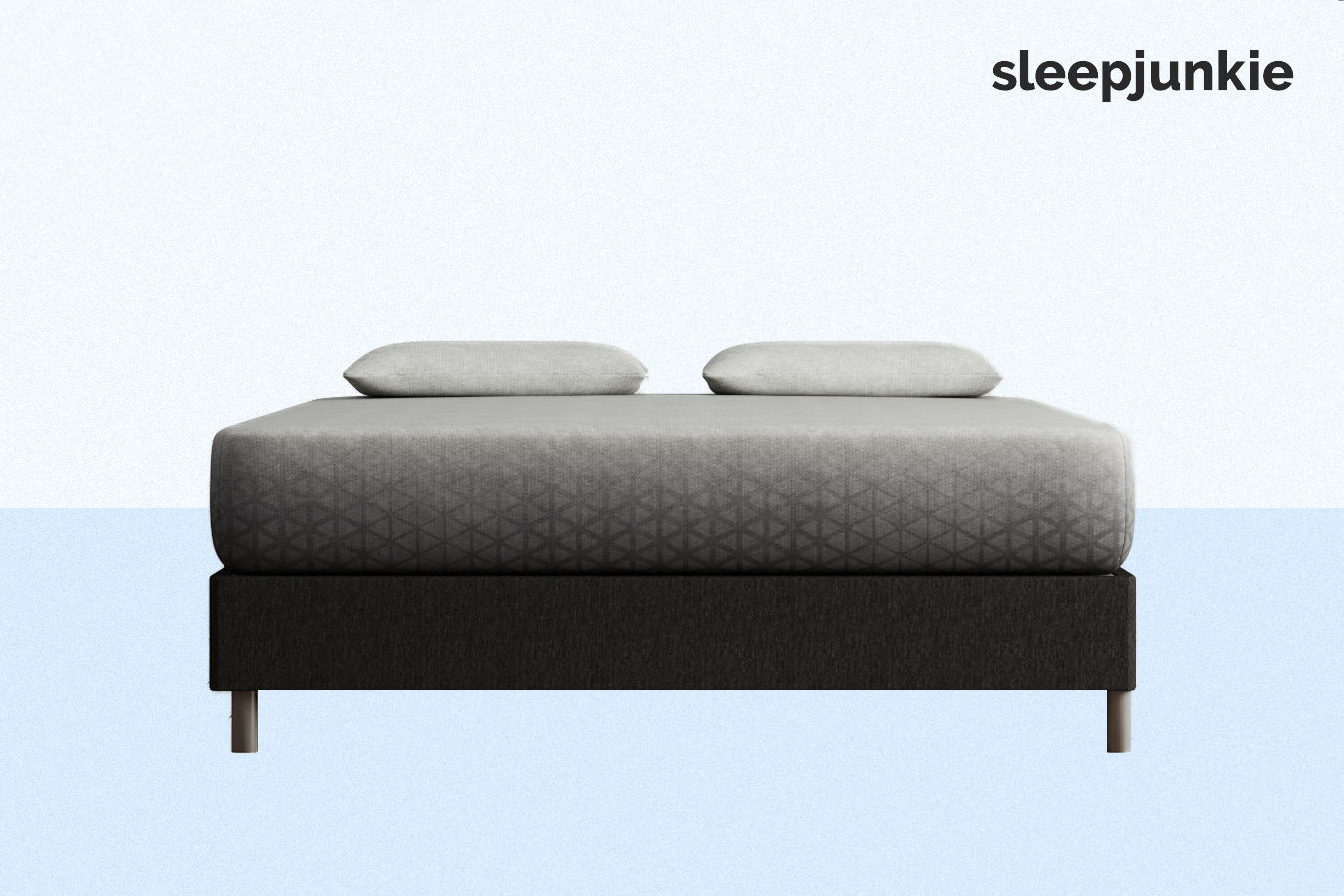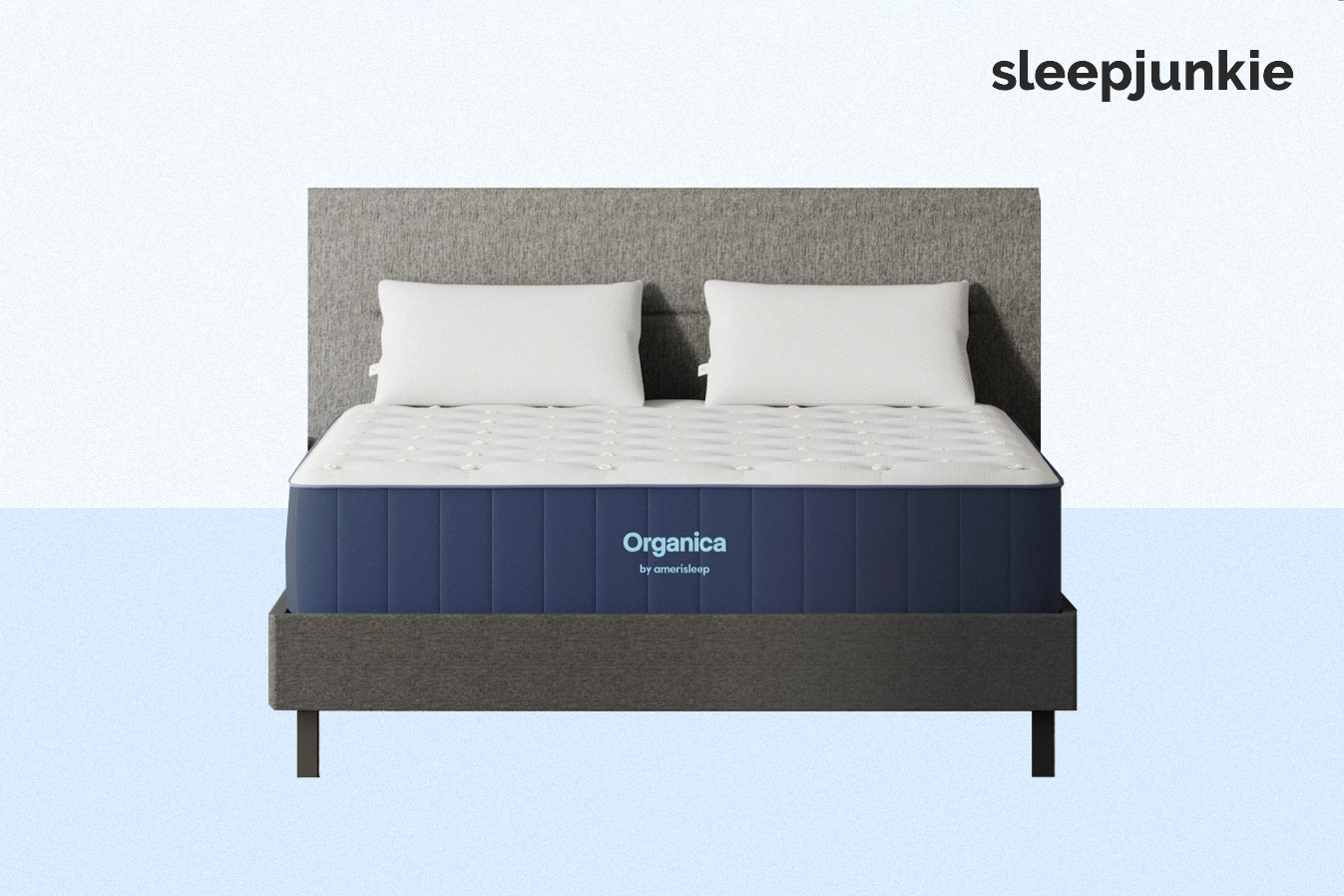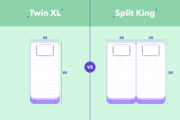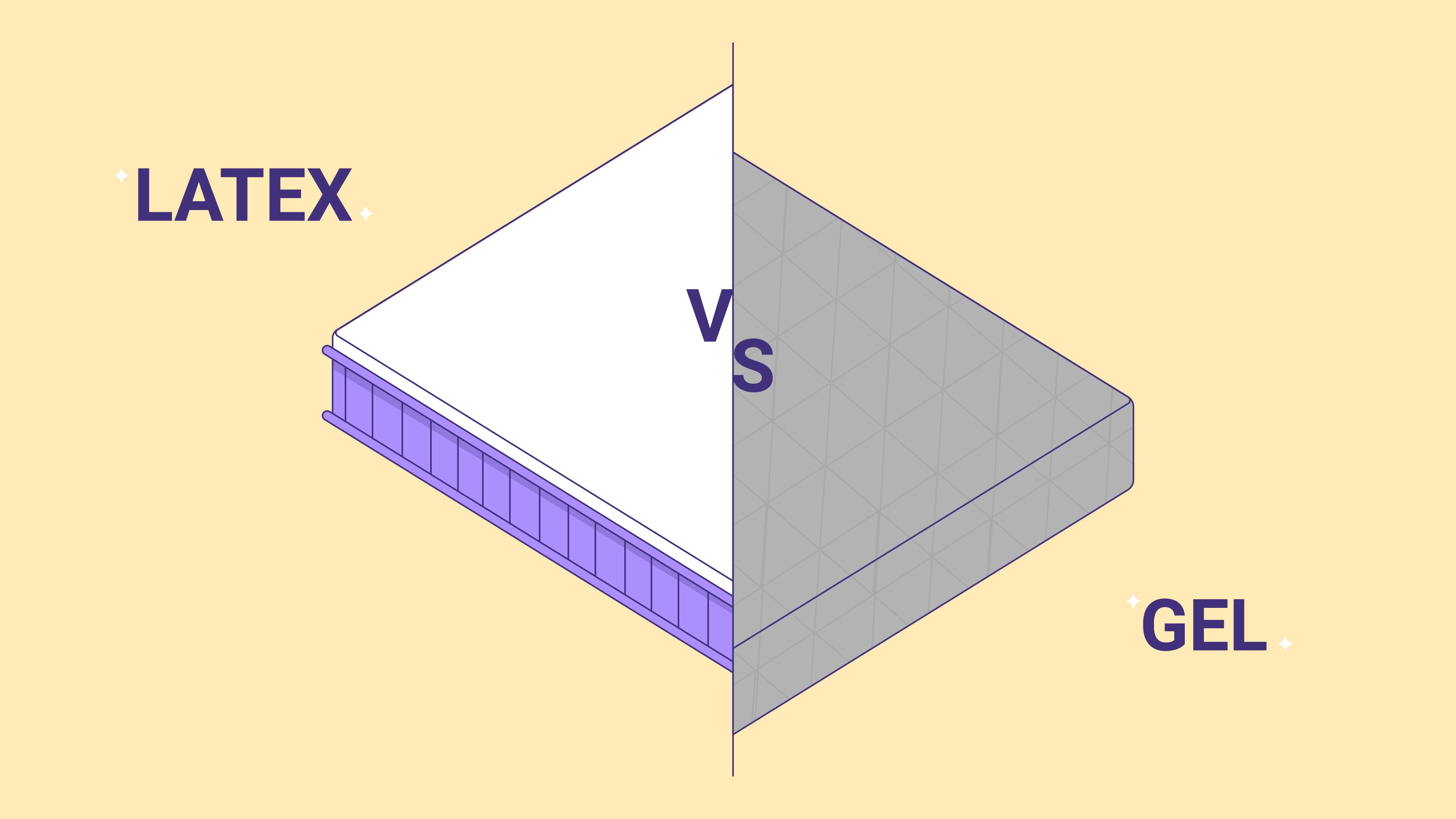
Gel Memory Foam vs. Latex: What’s the Difference?

- Gel memory foam and latex differ fundamentally; latex, a natural foam with bounce, contrasts with the synthetic gel memory foam, which offers contouring support.
- Gel memory foam incorporates thermally conductive gel to address heat retention, while latex, naturally cooling and breathable, is an effective option for hot sleepers without additional infusions.
- Choosing between gel memory foam and latex involves trade-offs; gel memory foam is more affordable with contouring support, while latex, though pricier, boasts durability and eco-friendliness.
Gel memory foam and latex are both cooling foams that can help hot sleepers get a good night’s sleep. However, they might both be cooling, but they’re made of distinct materials and can feel very different.
Latex is a natural foam, while gel memory foam is synthetic. Latex is bouncy, while gel memory foam is contouring. Latex is durable, while gel memory foam has a lower initial cost. These differences can have a huge impact on your sleep quality. So it’s important to know what you need and what you prioritize before you purchase.
Gel Memory Foam
Memory foam is made of flexible polyurethane. Traditional memory foam was popularized after NASA released their high-velocity flight foam design to the public. NASA’s foam was designed to keep pilots and astronauts safe during high-G flights. But the bedding industry quickly realized how perfect this contouring and cushioning foam could be for sleep.
Though memory foam was much more comfortable than its main competitor at the time (innerspring mattresses), one of its primary problems was heat retention. Traditional memory foam was downright sweltering.
The first fix for this problem was swapping closed-cell design for open-cell construction for extra breathability. Open-cell construction simply means that the foam has thousands of tiny air pockets running through it instead of being completely solid. Nowadays, virtually all memory foam is open-cell.
However, even open-cell construction was not enough to make the average memory foam truly cool to the touch. That’s where gel memory foam mattresses comes in. Gel is a thermally conductive material that helps move body heat away from you.
Gel can be introduced into your memory foam in several different ways. It can be swirled into the liquid foam before it’s solidified. Gel microbeads can be injected into the foam for even more breathability. A gel layer can also be laid over the top of a mattress’s memory foam layer for extreme coolness.
Gel isn’t the only infusion that memory foam can have. Other thermally conductive infusions include copper and graphite. Some memory foam mattresses swap out petroleum products for plant oils to create a cooling mattress. However, gel is still the most common option you’ll encounter.
Feel
Gel memory foam feels close to traditional memory foam, except it’s more cooling. Just like regular memory foam, gel memory foam is the most contouring material on the market. The gel infusions don’t impact the foam’s ability to mold itself to your shape.
A memory foam mattress follows the curves of your body. That means it offers the most customizable support. This translates into superior pressure relief and spinal alignment. However, there is a tradeoff.
Though heat retention is not much of an issue with gel memory foam, all memory foam has another major problem besides that. Slow response time is the other big complaint about memory foam, gel or not.
Memory foam can take a long time to regain its shape after you change positions. Those who stick to one position all night may not notice this. But active sleepers will likely find it annoying. There are infusions and transition foams that can help increase memory foam’s response time, but no memory foam will ever bounce back like latex.
Cost
Memory foam is the most affordable mattress material over time. While its average cost is slightly higher than that of innerspring mattresses ($1,100 vs. $950 for a queen), its increased durability over open coil systems means you won’t have to replace it as often. This translates into the lowest cost per year of use and many high-quality models are found among the best mattresses under $1000.
Gel infusions usually up the price of memory foam. Expect to pay up to a few hundred dollars more for gel memory foam than traditional memory foam. The increased price tag depends on factors such as brand and size. However, even gel memory foam will almost always have a lower sticker price than latex.
Durability
Just like regular memory foam, gel memory foam is stuck in the middle when it comes to durability. Pure memory foam mattresses don’t have any coils to lose tension and break down. That makes them longer lasting than virtually all innerspring mattresses and most hybrid mattresses.
However, latex smokes memory foam in terms of longevity. High-quality memory foam mattresses can last around 10 to 20 years. Meanwhile, natural latex’s minimum life expectancy is 20 years.
See Also: Memory Foam vs Latex Pillow
Purity
If you want all-natural materials, memory foam isn’t for you. Polyurethane foam is a manufactured material that’s made using petroleum products. Gel infusions are also typically artificial. That means almost every ingredient in a gel memory foam mattress will be synthetic.
However, unless you’re really dedicated to an all-natural bed, this shouldn’t concern you. As long as a memory foam bed has a CertiPUR-US® certification, you can rest easy. CertiPUR-US® certification means a mattress is low in Volatile Organic Compounds (VOCs) and contains no toxic ingredients like chemical flame retardants or heavy metals.
That means that even though memory foam is synthetic, you don’t have to worry about your mattress exposing you to dangerous chemicals as long as it meets CertiPUR-US® standards.
Eco-Friendliness
This is the one area where gel memory foam loses hands-down. There’s usually a tradeoff, like memory foam’s better contouring but slower response time. However, when it comes to environmental impact, latex is the clear winner.
Memory foam manufacturing uses lots of synthetic ingredients and produces lots of toxic waste. Furthermore, memory foam is not biodegradable. That means if you can’t recycle your mattress, it could spend thousands of years in a landfill. Not very earth-friendly.
Allergies
A gel memory foam bed can serve as a hypoallergenic mattress, as the natural density of memory foam keeps allergens from settling. Whether or not a gel foam mattress is the right choice to ease your allergies will depend on what materials trigger your symptoms. If you’re sensitive to synthetic materials, you may want to reconsider.
The Zoma Mattress is designed by athletes for athletes. But this performance mattress is a fantastic bed for anyone. It conforms to your body to provide the perfect balance of pressure relief and spinal support. And it offers tons of cooling technology to prevent overheating and wick away moisture.
On top, you have the ultra-breathable AirCloth cover that helps keep air moving underneath your body and prevents you from sweating. The AirCloth cover also works with the gel memory foam comfort layer to provide enhanced cooling comfort.
The gel memory foam also has the added feature of being tri-zoned. The Triangulex™ comfort layer offers targeted pressure relief to different areas of the body to cushion shoulders and hips while lifting the back.
Below the comfort layer, a transition layer of Reactiv™ foam helps add responsiveness. This bouncy transition layer helps the slower-to-respond comfort layer spring back into place as soon as you move. So even active sleepers can enjoy this gel memory foam mattress.
To round it all out, the Zoma’s ultra-firm, ultra-dense Support+ base layer provides the ultimate spine aligning support. Not only does this support core keep you lifted onto the sleeping surface to prevent sink. It also fights sagging and soft spot development for a full ten years.
ZOMA MATTRESS
- Gel infusions promote a cool-to-the-touch surface
- Buoyant transition foam minimizes unwanted sinkage
- Mattress resists sagging and promotes healthy spine alignment
Those who want an extra bounce in their bed should check out the Organica by Amerisleep. Active sleepers will especially love the extra responsiveness of this bed. The Organica features all the bounce of an innerspring and none of the sagginess or motion transfer.
The Talalay latex comfort layer is easier on the pressure points than Dunlop latex. It’s almost as contouring as memory foam, and it’s twice as responsive. In addition to its faster response time, the springy Talalay latex in the Organica is also ultra-breathable. It works with the pocketed coil core to keep air moving through the entire mattress.
Above the bouncy, breathable comfort layer, you’ll find the organic cotton cover and New Zealand Joma wool fire barrier. The cotton cover is as breathable as the Talalay latex underneath it, meaning this mattress will wick away sweat all night long. Meanwhile, wool is a common feature in some of the best mattresses without fiberglass.
The Joma wool fire barrier eliminates the need for chemical flame retardants. It also offers the added benefit of extra cushioning for pressure points.
Underneath all this cushioning comfort, you’ll find the highly adaptable pocketed coil core. This system of individually wrapped coils offers much more flexibility and durability than traditional innerspring coils. The pocketed coils also have the added benefit of increasing the bounce of the already bouncy latex.
One of the best things about the Organica is it’s one of the most durable hybrid mattresses on the market. Because the Organica is a latex hybrid, it will last a full 20 years. This is around five years more than the average hybrid life expectancy of 15 years.
AMERISLEEP ORGANICA
- Heat-wicking cotton fabric cover and wool layer
- GOTS-certified wool fire barrier eliminates chemical flame retardants
- Pocketed coils feature motion isolation and edge support
Natural Latex Foam
Natural latex foam comes from the sap of the rubber tree. Raw rubber is harvested from trees by tapping them and draining the sap. This liquid sap is then processed into rubber and latex products, including everything from gloves and balloons to latex mattresses.
There are two basic types of natural latex: Dunlop and Talalay. They both come from the same raw sap, and the only difference between them is the way they’re processed. Dunlop latex is slightly more eco-friendly than Talalay latex because its manufacturing process is simpler and more energy-efficient. Dunlop latex is also slightly less expensive than Talalay.
However, keep in mind that the differences between the two latex types are small. You will notice the distinction between Dunlop and Talalay latex a whole lot less than the distinction between natural latex and memory foam.
With latex, you also have the option to go organic. Since latex is an all-natural material, you can find many certified organic mattresses that are even purer and more ecologically conscious than their non-organic counterparts.
Feel
Natural latex solves both of memory foam’s primary problems without the need for infusions or extra ingredients. Latex foam is naturally cooling and naturally bouncy all on its own. It will spring back into place as soon as you move. This is amazing for active sleepers who like to toss and turn.
However, just like with gel memory foam, there is a tradeoff. Latex works harder to retain its shape than memory foam. That makes it less able to take your shape. Latex’s lowered contouring can make it slightly less pressure relieving than memory foam. But most sleepers likely won’t notice much difference in feel.
Latex still contours well enough to align the spine. And different firmness levels mean you can still find the pressure relief that fits your needs.
Eco-Friendliness
All-natural latex is better for the environment than any type of memory foam. Organic latex is especially eco-friendly because GOLS-certified latex must adhere to strict standards limiting environmental impact.
Organic latex produces less toxic waste and fewer greenhouse gasses than other mattress materials. It’s also biodegradable. So your latex mattress won’t be around forever after you replace it.
As a reminder, organic and natural mattresses are not the same thing. To rightfully claim a material is organic, manufacturers must meet a number of conditions, while natural is far less regulated as a term.
Allergies
Latex beds top many lists when it comes to mattresses for allergies. However, if animal products, latex foam, or natural fibers trigger symptoms, another material may suit you better.
Cooling Alternative: Hybrid Mattresses
If you want some extra bounce in your cooling mattress, there is a third option. Hybrid mattresses offer the cooling breathability of coils and the contouring power of foam. Hybrids combine at least two inches of foam in the comfort layer with a support core of pocketed coils.
Cost
The initial price of natural latex isn’t pretty. At $2,000 for an average queen, natural latex has the highest price tag of any type of mattress. But its incredible durability means latex can compete with other mattress materials in terms of long-term cost, saving shoppers from having to replace their mattress too soon.
Durability
Latex whips all other mattress types in this category. Natural latex mattresses can last around 20 years. Most make it well past that. A few well-maintained Dunlop latex mattresses have even been known to make it to the ripe old age of 40. This means you won’t be replacing your latex mattress anytime soon.
Latex’s fantastic durability offsets its high initial cost in the long run. But even with its unbeatable durability, many memory foam mattresses are so affordable they’re still the cheaper option, even long-term. But many people find the convenience of being able to avoid replacing their mattress for decades worth the added expense.
Purity
If you want an eco-friendly mattress made with only plant-based materials, latex is just about your only option. Natural latex is the only foam in the mattress industry that is made entirely of plants. Natural latex has the lowest amount of potentially harmful chemicals.
Organic latex is especially pure. Natural latex with a Global Organic Latex Standard (GOLS) seal is pretty much just natural latex and nothing else. That’s perfect for everyone looking to avoid any and all synthetic materials.
For those who need extra contouring but don’t want to completely lose the feel of an innerspring mattress, a hybrid is an excellent alternative. The best thing about hybrid mattresses is that you don’t have to choose between a hybrid and a latex or memory foam mattress. You can have both!
Gel memory foam and latex foam are both featured in plenty of hybrid mattresses. If you want a contouring and still bouncy gel memory foam bed, a gel memory foam hybrid might be for you. Those who want a combination of the bounciness of coils and the springiness of latex should spring for a latex hybrid.
The wonderful thing about hybrids is you don’t have to choose between springs and foams. Hybrids may be the best option for the hottest and most active sleepers because their coils offer even more airflow than latex alone, and they’re the best solution to the problem of slow response time in gel memory foam.
However, there is a downside when it comes to how long a mattress lasts. Hybrid mattresses are less durable than pure foam mattresses because their coils lose tension and break down. This will eventually lead to sagging and can shave years off a hybrid’s lifespan. But hybrid mattresses are still more durable than innerspring mattresses, which can normally only be expected to make it to 10 at best.
See our hybrid mattress buying guide for more information.
Other Ways to Keep Cool at Night
While a cooling mattress such as a gel memory foam, latex, or hybrid bed is important to prevent sleeping hot, it’s not the only consideration. For example, if you’re not ready to invest in a cooling mattress, you can look at cooling mattress topper.
A crucial part of staying cool at night is having the right breathable bedding. A set of cooling sheets can wick away heat and allow airflow through. A blanket or comforter should ideally have an all-seasons design so it stays cool when it’s warm and warm when it’s cool.
Another important accessory is a cooling pillow. It should keep the head from overheating and causing discomfort, while also supporting the neck’s spine in a neutral position.
Sleepers will also want to make sure their pajamas are loose and airy, especially during the warmer months.
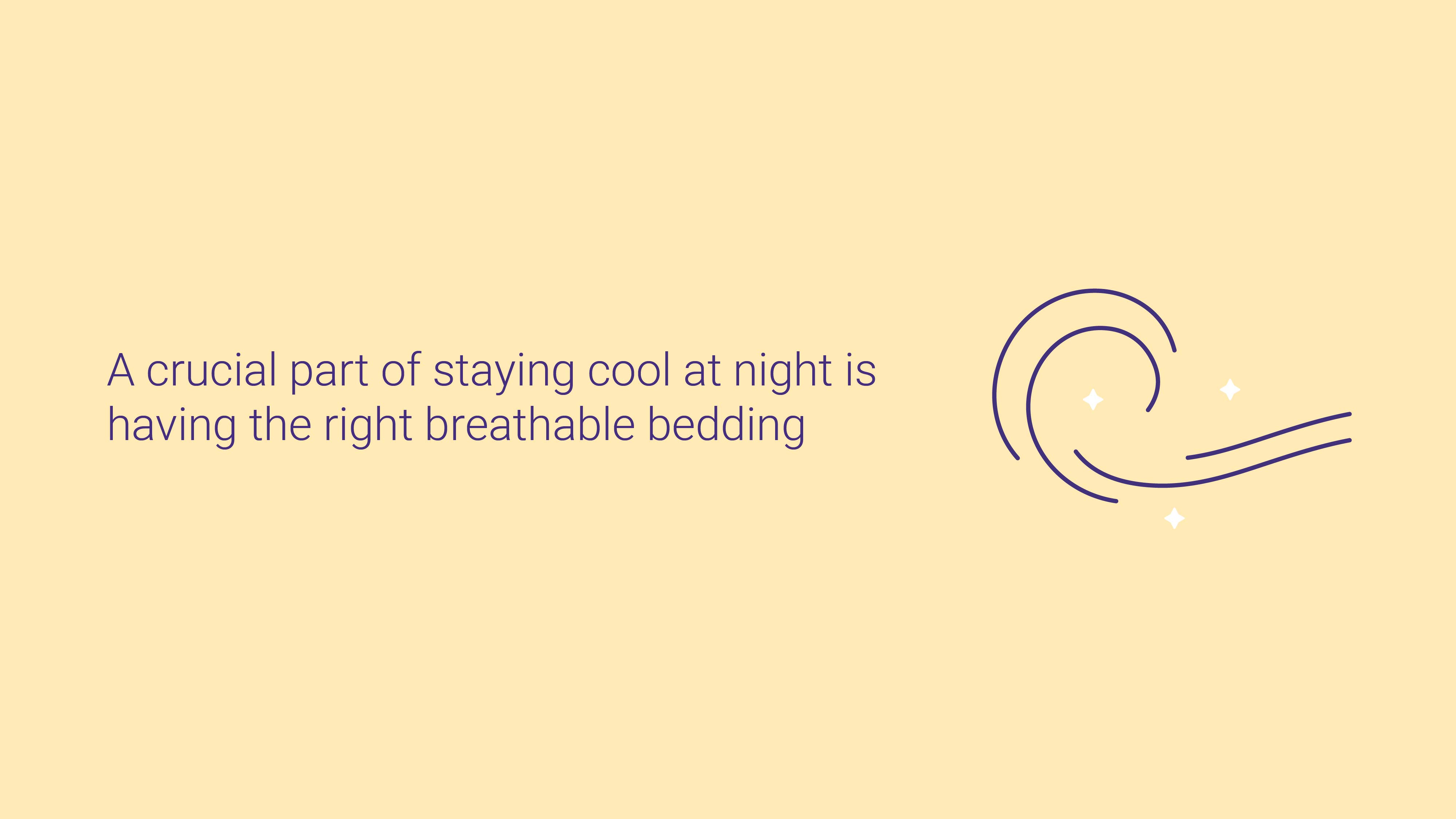
FAQs
Which is better for people with allergies, gel memory foam or latex?
Both gel memory foam and latex fight allergens such as dust mites, pollen, and mold/mildew. They’re both breathable and create hostile environments for microbes. That means sleepers with allergies will do well with either option.
One thing to watch out for is latex allergies. While latex is wonderful for fighting allergens, it’s not so great if you have a latex allergy. Those who have an allergy to latex would be better off with gel memory foam.
Is synthetic latex the same as natural latex?
Absolutely not. Styrene-Butadiene Rubber (SBR) is a synthetic latex alternative made out of petroleum products. It’s marketed as an alternative to natural rubber. For things like tires, yoga mats, and shoe soles, SBR is a fine latex substitute. The same cannot be said for mattresses.
SBR foam fails to mimic the breathability, support, and bounce of latex. It’s more like the sweltering, slow-to-respond memory foam of the 90s. SBR usually comes in cheap and low-quality mattresses. It will not support your body the way you need to maintain neutral alignment in your spine. SBR also will need to be replaced often.
Does gel memory foam off-gas?
All memory foam off-gasses. Off-gassing occurs when you unpack your new memory foam mattress. After unboxing, VOCs in the foam are then emitted into the air. This is what causes that “new mattress” smell.
Off-gassing is almost never hazardous to your health. With a CertiPUR-USⓇ certified mattress, you may not even notice the chemical smell because the VOC levels are so low. Higher VOC levels can cause mild symptoms like headache and nausea. But they won’t harm you, and they will dissipate after a while.
If you want a foam mattress that won’t off-gas at all, latex is your only option. Only latex has zero VOC emissions.
Is Talalay latex better than Dunlop latex?
There isn’t really an objective answer to that question. The best latex type for you depends on what you want. Talalay latex is lighter and springier than Dunlop. It will contour better and be more breathable. On the other hand, Dunlop is denser and more durable than Talalay. It will last longer and offer more support.
Another thing to keep in mind is that only Dunlop latex can snag a GOLS certification. The Talalay process involves steps that preclude the final product from being certified organic under strict GOLS standards. That means Talalay can be certified all-natural/pure under other criteria, but if you want truly organic latex, you have to go for Dunlop.
Which is best for active sleepers, latex or gel memory foam?
If you toss and turn all night, latex is probably a better option for you. Unless you get a hybrid mattress, there is no transition foam or infusion that will make gel memory foam as responsive as latex. Latex will bounce right back into place as soon as you move. That means active sleepers won’t have to wait for their mattress to recontour as they move around at night.
Bottom Line
The best mattress for you depends on multiple factors. Those who need lots of contouring and pressure relief in addition to temperature regulation should consider gel memory foam. Those who need responsiveness and all-natural purity should go for latex. Whatever decision you make, both these materials can offer you an amazing night’s sleep!
